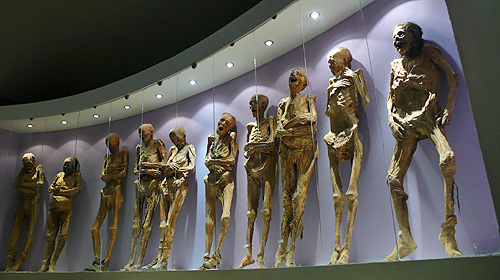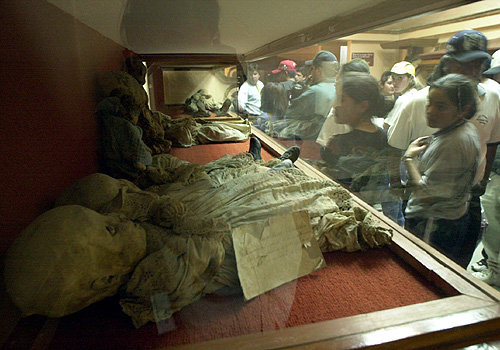 |
 |
| The mummies at a Guanajuato museum were preserved
naturally, thanks to the
airtight and arid conditions of their tombs. |
A collection of 56 mummified corpses
is a tourist draw in
Guanajuato, Mexico. |
Guanajuato's mummies are a window on the past
 |
 |
| The mummies at a Guanajuato museum were preserved
naturally, thanks to the
airtight and arid conditions of their tombs. |
A collection of 56 mummified corpses
is a tourist draw in
Guanajuato, Mexico. |
The bodies, dating from the mid-1800s to the 1970s, are remarkably intact. A museum hopes to use them to teach about the city, whose mining legacy reaches to the days of the Spanish rulers.
By Ken Ellingwood
Reporting from Guanajuato, Mexico — Juan and Remigio and Ignacia and their closest neighbors can tell you a lot about life in this central Mexican mining town.
So what if they're dead?
They might be Guanajuato's most visited residents -- a collection of 56 mummified corpses that survived for years in remarkably good shape and now constitute one of the main tourist draws here.
The bodies, on display in Museo de las Momias, the city's mummies museum, were taken from above-ground crypts in a graveyard next door. Dating from the mid-1800s to the 1970s, they were removed because they were unclaimed or relatives hadn't paid burial fees. Long a ghoulish curiosity while in storage, the mummies were put on formal display starting about 40 years ago.
Don't look for Scooby Doo-style creepers trailing bandages -- most of these mummies are naked. They are dry as paper and coppery-looking, but often surprisingly complete, with tufts of hair on the face and body and, in some cases, clothing that still has some of its color.
Museum officials say the tightly sealed crypts kept marauding bugs out and the arid conditions allowed the bodies to dry intact even without the preservation efforts used in ancient Egypt.
"This is why these are the best mummies in the world," said museum coordinator Carlos Barrera Auld. "It's a natural mystery."
The bodies are encased -- some standing, others in repose -- in the museum building near downtown Guanajuato, where you can catch the bus labeled "Mummies." In several cases, names and bits of biography of the dead are known. They're miners, mothers, doctors, Mexicans and foreigners. They seemed to fall young.
One man, exhumed in the 1940s, had been stabbed to death, a golf-ball-sized wound visible in the parched husk beneath his rib cage. Another drowned in the 1970s. A woman from the 1920s is thought to have been buried alive after slipping into catalepsy. Her hands are frozen hauntingly above her face, apparently in mid-struggle to escape her grave. Nearby is a neat row of desiccated babies, some adorned with dainty cotton bonnets.
In the United States, this sort of exhibition might be relegated to an old-style freak show. But Mexico doesn't shy away from death. After all, families gather in cemeteries to share memories and celebrate departed loved ones at graveside on the annual Day of the Dead.
Museum managers say they hope to get away from ghoulishness and instead use the bodies to teach about the history and culture of Guanajuato, whose silver- and gold-mining legacy reaches to the days of the Spanish rulers.
"It's not just to see the mummies -- the ugly faces. We are working to spread the traditions and the way Guanajuato people lived in the past," said museum director Juan Manuel Guerrero. "These were people, real people."
For example, Guerrero said, the number of bodies of foreigners that went unclaimed underscores how Guanajuato and its mines drew transplants from all corners: China, France, Greece and the United States.
There is something, too, to be learned about the lives of women, who also worked at the mines. The body of one mine helper is clad in blue skirt and head scarf. Her scrawny build suggests a life of toil and deprivation.
Museum officials plan a section devoted to the mining industry. And they are seeking to learn more about how each of the subjects died.
Findings could fill in details of a city history that already holds calamitous floods, cholera outbreaks and less spectacular endings.
Some mummies have gone on the road. Last fall, 24 were packed up and shipped for display in the northern Mexican city of Monterrey. There's been talk of a traveling exhibition in Mexico City and, perhaps, the U.S.
For now, the mummies' main visitors are the tourists who show up with a macabre curiosity and strong stomach.
Marcus Felsman, a 25-year-old Australian, was among a group of foreign teachers who visited recently. The mummified babies were too much, he said.
"I like morbid stuff," Felsman said. "But I was surprised."
A British traveling companion, 29-year-old Amy Gregg, giggled self-consciously, as if she'd been caught sneaking a peek at a bearded lady.
"It's kind of embarrassing," she said, "to be interested in that kind of thing."